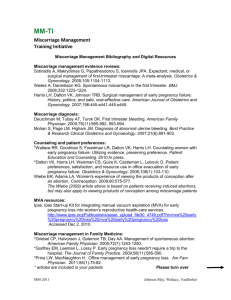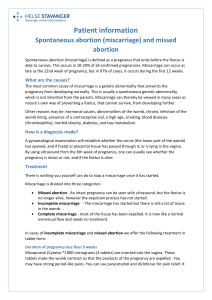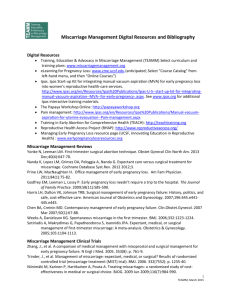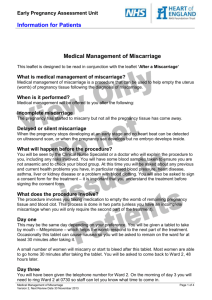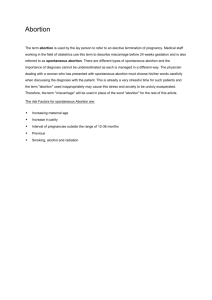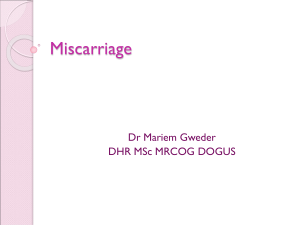Dr Vijaya lakshmi
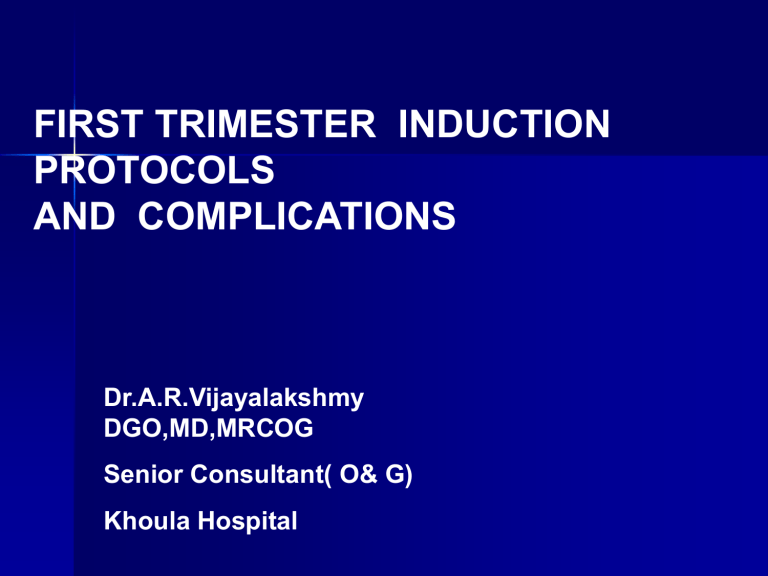
FIRST TRIMESTER INDUCTION
PROTOCOLS
AND COMPLICATIONS
Dr.A.R.Vijayalakshmy
DGO,MD,MRCOG
Senior Consultant( O& G)
Khoula Hospital
INTRODUCTION
• First Trimester Induction applies to those terminations on Medical grounds and
Miscarriage
• Miscarriage occurs in 10-20 %
• Surgical Evacuation – Conventional method
• Effective Non Surgical Alternatives
• Early Pregnancy Assessment Units (EPAU)
EAPU(Bigrigg and Read 1991)
• Streamlines the management of early pregnancy problems with improved efficiency and quality
• Hospital admissions reduced by 40% and 20% shorter stay
• Cited in a dedicated area with
Appropriate Staffing and Facilities
Efficient Appointment system
Direct access for GPs and selected patient groups
TVS,BHCG,Serum Progesterone
• Available on all days ,minimum 5 days in the morning ,Clinical Guidelines for management
TERMINOLOGIES
33rd RCOG Study Group 1997
Spont.Abortion
Miscarriage
Threatened abortion Threatened miscarriage
Inevitable abortion
Incomplete abortion
Inevitable miscarriage
Incomplete miscarriage
Complete abortion
Missed abortion
Anembryonic pregnancy
Complete miscarriage
Missed miscarriage
Early fetal demise /Silent miscarriage
Blighted ovum
Septic abortion
Recurrent abortion
Delayed miscarriage
Miscarriage with infection
Recurrent miscarriage
European Society for Human reproduction
Special Interest Group for Early Pregnancy -
Revised Nomenclature(2005)
Term Definition
Biochemical preg.loss
Pregnancy not located on scan
Empty sac Sac with absent or minimal structures
Fetal loss Previous CRL measurement with subsequent FH loss
Early pregnancy loss Confirmed empty sac or sac with absent FHA <12 wks
Delayed miscarriage As early preg.loss
Late preg.loss
Loss of FHA >12 wks
Pregnancy of unknown location
No identified preg.on US ,+ve Hcg
MANAGEMENT
•History/Preexisisting conditions(Cardio resp,Coag.disorders)
•Examination ,Ultrasound
•Investigations
•Informed Consent
• Management Options
Expectant
Medical
Algorithm
Surgical
INDUCED MISCARRIAGE - FIRST
TRIMESTER
Mifepristone Misoprostol /Methotrexate Misoprostol or
Misoprostol alone
IPPF and WHO 2007
Mifepristone 200mg followed 36 –48 hours later by 800μg misoprostol (orally, sublingually, buccally or vaginally)at once or in two doses of 400μg two hours apart, up to 9 completed weeks after last menstrual period.
US FDA
Day 1: Mifepristone 600mg (three 200mg tablets) taken as a single oral dose.
Day 3: Unless abortion has occurred and is confirmed by clinical examination or ultrasound administer misoprostol400μg (two 200μg tablets) as a single oral dose
Methotrexate/Misoprostol Protocol ( OBG
Society of Canada 2008)
Methotrexate 50mg/SqM Intramuscular on the deltoid
On5th,6th or 7th day afterMethotrexate, 800ugm Vaginally
If no bleeding or passage of tissue after 24 hrs, rpt 800 ugm
On the D3 and D7 days
•If Bhcg has fallen by >80% over 7days,procedure was successful
•If not, a weekly Bhcg estimation till level reaches 0 or interval decrease is >80%
• If Bhcg level plateaus or increases - Incomplete miscarriage or ongoing gestation - Suction Evacuation
Once termination is complete ,confirm a nonpregnant non tender uterus by bimanual pelvic examination
INDUCED MISCARRIAGE PROTOCOL
(CONTD )
MISOPROSTOL ALONE
Misoprostol 800ugm Vaginally –every 24 or 48 hrs
( Day1-5) until abortion occurs or a total of 3 doses
Bhcg on Day 1 and D7 .If Fallen >80% -success. Repeat another after 1 wk to ensure continued decline .
If not fallen to the desired level, rpt wkly till reaches 0 or interval decrease is > 80%
If rises or plateaus - Vacuum aspiration
Ultrasound may be used instead of B hcg assays
WHO Expert Group 2007
Misoprostol 800 ugm Vaginally12 hrlyx 3doses ( Ideally after 48 hrs of Mifepristone 200 mg)
EXPECTANT MANAGEMENT IN
MISCARRIAGES
•Effective and acceptable for selected group of women
(Level 1b).
•Should be offered to women who have access to emergency admission if required.
•Successful in 2-6 wks without increasing complications in
80-90% of women with Incomplete miscarriage and 65-
75% of women with Delayed miscarriage/Empty sac
(Butler C. et al J.Fam.Practice 2005) .
EXPECTANT MANAGEMENT IN
MISCARRIAGES (CONTD.)
•Those with intact sac may take several wks and efficacy low.
• Success depends on various factors like
Type of miscarriage
Duration of follow up
Ultrasound or Clinical
• Low serum Progesterone may be used to predict outcome
SURGICAL MANAGEMENT( Suction Evacuation)
Treatment of choice for Intact sac ,Incomplete miscarriage with ET >50 mm ,Heavy bleeding, Unstable Vital signs or
Infection,Suspected molar pregnancy ,Patient’s choice
Advantage of Suction Evacuation
•Safe and Quick
•Significantly reduced blood loss ( Cochrane review 2001)
Need for Cervical priming assessed ( Misoprostol 400 ugm) oral or vaginaly)4 -12 hrs prior
Reduces cervical laceration and uterine perforation up to 80%
Antibiotic Prophylaxis individualised ( 1gm Metronidazole) rectally at surgery followed by oral Doxycyclin 100mg BDx
7days)
SURGICAL MANAGEMENT ( CONTD)
• Canula size in mm should be equal to or > than the
Gest.age in weeks ( B)
•Use of Oxytocin associated with clinically significant decrease in mean blood loss ( 17.6 mlVS 24.5 ml ) Level 1a
•Suspected Infection – Intravenous Antibiotics for 12 hrs prior to Evacuation
• Serious Morbidity and Mortality – 2.1% and 0.5/100,000 in Induced abortion ( Level 3 Evidence)
Others
Incomplete Miscarriage 2/1000,
Haemorrhage,Cervical trauma,uterine trauma 1/1000
COMPLICATIONS
Cervical shock ( Vasovagal ) – Para cervical block
Tonic Clonic reaction – confused with seizure
Bradycardia, rapid recovery ,absence of post ictal state – differentiates
Pre op Cervical priming – prevents the Cervical shock
Perforation – Presentation depends on the site
At Isthmic portion – May lacerate the ascending branch of uterine artery-- haematoma in the broad ligament/ intraabdominal bleed
Immediate Laparotomy and ligation of severed vessels / repair of uterine injury/Hysterectomy( rarely)
COMPLICATIONS (CONTD )
Low Cervical perforation May injure descending branch of
Uterine artery in the Cardinal ligament- due to forcible dilatation
• Deaths due to delayed bleeding can occur hrs or days later
• Management - Embolisation /Hysterectomy
• Fundal Perforation - Stop the Suction ,Laparoscopy/
Laparotomy and complete the evacuation under vision ,repair the damage
• Haemorrhage – Uterine atony,Lowlying limplantation,
Perforation
•Misoprostol 1000ugm rectally /Oxytocin /IM PG f2 Alfa
• Persistent bleeding – Retained tissue,Perforation
MEDICAL MANAGEMENT - As Out patient
( Level 1b)
• Induced miscarriage
• Incomplete ,Silent/Delayed / Missed miscarriage
• Early fetal demise
Variety of regimens described including Gemeprost,
Mifepristone followed by Misprostol ,Methotrexate -
Misoprostol and Misoprostol alone
Misoprostol > 600 studies 90,000women
PGE1 analogue ,cheap, highly effective,acts via various routes , easy storage ,fast absorption ,peaks after 12 minutes of oral and 60minutes after vaginal
Half life 20-30 minutes
( Bioavailability varies with route)
Myometrial contractions by interacting with specific receptors on myometrial cells - Cascade of events
change in calcium concentration and muscle contraction
MEDICAL MANAGEMENT CONTD
• Alternative method- does not replace surgical evacuation
• Availability Improved choice
• 20% willing to choose medical method as could avoid anesthesia and feels more in control ( Level 1 b)
• Local protocols should be developed with selection criteria ,theraputic regimen and follow up ( Good practice)
• Should be counselled that bleeding may continue for
3wks
Rule out Contraindications
Absolute
Adrenal insufficiency ,Long term steroid trt , Hb<10 gm%,
Hemoglobinopathies,Glaucoma,Mitral stenosis ,Coagulation disorders,Hepatorenal diseases,Acute Inflammatory bowel disease , Porphyria ,NSAIDS ingestion in the preceding 48 hrs(?) Pelvic infection/sepsis, known allergy
Relative – Hypertension, Severe Asthma
To date no standard protocol for the use of Misoprostol as single agent
•Variety of doses and differing dosing schedules
Success depends on various factors like
•Type of miscarriage,Sac size ,Total dose
,Route,Duration,Clinical or US follow up
• High success rates with Incomplete ,High dose Vaginal and Clinical follow up
INCOMPLETE MISCARRIAGE (Upto 12 wks
• Single oral dose of 600 ugm - Successful in > 1000 women in > 6 trials world wide ( Int.J OBG 2007)
•Vaginal 800ugm –Single dose ,Oral 400ugm Single dose
•Single and Rpted doses of oral 600ugm ,maximum 1200 ugm –found to be equally effective ,lower incidence of diarrhoea in single dose group ( Ngutyen TN etal –
Contraception 2005)
•Success 61-95%,bleeding for 6 days
Sublingual 400 ugm has also been evaluated -
Success of 94.5%
Both Sublingual 400 ugm and Oral 600 ugm –Equally effective for Incomplete miscarriage ( FIGO 2006 )
In many low resource countries ,with women having limited access to Secondary and Tertiary Care ,could use for
Incomplete miscarriage ( 17 th Expert Committee on
Selection & Use of Essential Medicines, Geneva March
2009)
Cohrane Review including 19RCT on
Pregnancies <14 wks reported that Vaginal
Misoprostol reduces the time to expulsion when compared with Placebo
Doses used 400 ,600 or 800 ugm.
Lower doses 2RCT-less effective
Author Dose&
Route
No Succe ss
Define d
Pang 2001
Blanchard
2004
Ngoc 2004
800Vag 2doses 4 hrly
600 oral 2doses
4hrly
96 pt
87Pts
– 61%
70%
600 oral2doses
4hrly
150 pts 94%
Blohm 2005 400 Vag 1dose 64 pts 88%
Zhang 2005 800 Vag 48hrly
2doses max
Shwekerela
2007
30pts 93%
600 oral 1dose 150pts 99%
Dao 2007 600 oral 1dose 223 pts 94.5%
< 24 hrs
2 wks
9days
2 wks
1wk
2wks
1wk
CONTD
• Hospitalisation not necessary
• Time to expulsion varies ,bleeding heavy for 3-4 days may last >14 days with additional days of spotting
• Women with Previous CS
• No reason to withhold ,while many trials have excluded
• For Uterine size < 12 wks misoprostol reported safe with scar
ADVANTAGES OF MEDICAL
METHODS
• Does not increase the infection rate
• Avoids surgery and anaesthesia
• Emotionally easier for some women
• Client controlled; more privacy and autonomy;
• Better than surgical in very early gestation, or with
• severe obesity (body mass index >30) without other cardiovascular risk factors, or in the case of fibroids, uterine malformations or previous cervical surgery
• No risk of cervical/uterine injury
SILENT ,DELAYED ,MISSED OR EARLY
FETAL DEMISE
A Confusing number of regimes using Misoprostol alone
(Oral,Sublingual or Vaginal) in doses of 400,600 or 800 ugm in single or repeated doses
Oral Mifepristone 200,400 or 600 mg followed by 36-48 hrs later by Misoprostol or Gemiprost 0.5- 1mg Vaginally
Success with Mifepristone+ Misoprostol 70-84% with Induction to miscarriage time of 8hrs and
Satisfaction rate of 91% ,Bleeding stopped in 8 days
Mifepristone not necessary in above miscarriages as Progesterone levels are low
Vaginal route preferred -Early expulsion than
Oral
Sublingual route –Fatigue and diarrhoea higher ( Tang OS et al , Human Reproduction 2003,NgOC et al Int.J O&G 2004
Single dose Vaginal 800ugm –more effective than 400 ugm
(55% VS 40.2 %) in delayed miscarriage compared with empty sac (50 % Vs 40%)
Larger and Rpt doses needed in those with Empty sac
There is no randomised evidence to guide practice in cases of 1st Trimester miscarriage particularly in cases of intact sac
Suction evacuation - high satisfaction and acceptability
SOME OF THE REGIMENS IN EARLY
PREG.FAILURE
•Chung et al 1995 - 400 ugm oral 4hrly 3doses ,141pt -
62%
•Nielson et al 1997 -400 mg Mifepristone -36 hrs Oral Miso
400 ugm – 31 pts , 52%
•Zalayani et al 1998 – 200 ugm Vaginally 4hrly X 4doses –
25pts -88%
•WoodSL et al 2002 - 800 ugm Vaginal ,Rpt at 24 hrs –
50 pts- 84%
•TangOS et al 2003 – 600 ugm Vag or SL 3hrlyx 3doses –
80 pts – Successs -87.5% in both , diarrhoea ,fatigue more in SL,otherwise comparable side effects ( RCT)
CONTD.
• Davis AR et al 2002 – 800 ugm Vag -24 hrlyx 2 doses –
80 pts – 85%
•Ngoc et al 2004 – 800 ugm Oral or Vaginal – 200 pts
89 % and 92.9% success
•Reynold et al 2005 – 600 ugm Vaginally 4hrly x 3 doses – 44 pts – 86 %
•Zhang 2005 - 800 ugm Vaginal – Rpt at 48 hrs if POC
- 652 pts ,77% after 1 dose and 84 % after 2 doses
• WHO Expert Group 2007 – 800 ugm Vaginally 3hrly or Sublingual 600ugm 3hrly – Give 2 doses and leave for 1-2 wks
SIDE EFFECTS AND COMPLICATIONS
Nausea,Vomit ing
5-33% ( resolves in 2-6 hrs)
Diarrhoea 3.8 %
Fever 0.4 – 2 %
Chills 5- 8 % ( Subsides in 24 hrs)
Cramping
Rarely mild rash
56 – 95%(Starts in minutes- few hrs )
Infection rate - Not different from other methods ( 2%) Vs
3%
No adverse effect on future fertility ( Level 1a)
Rupture up to 4% in Previous CS and
High Parity after 12 wks ( 12-24 wks )
COMPARISON BETWEEN DIFFERENT
MANAGEMENTS
•Only few RCT comparing Expectant ,Medical and
Surgical for Incomplete Miscarriage and Early fetal demise
• MIST trial ( BMJ 2006 ) Trinder J et al. Signicantly more unplanned admissions and surgical curettage after
Expectant and Medical management than Surgical
• Infection rate was low ( 2-3 % ) regardless of method
A meta analysis reported in Obst.Gyn 2005
,Surgical had the best success rate followed by
Medical and Expectant although many were of poor methodological quality
Cochrane review 2006 ,Expectant –> High risk of incomplete miscarriage,bleeding ,need for surgical evacuation .
However no strong argument for either approach
• Individual woman’s preferrence - major concern
• Filmy adhesions reported in7.7% of Surgical cases
• Longterm conception rates and pregnancy outcome similar in both Medical and Surgical methods
• Median time to achieve pregnancy – 8 months
• Cost – Misoprostol least costly,followed by
Expectant and Surgical Evacuation ( Pooled data)
• Other studies – Report otherwise
WOMAN’S PERSPECTIVE ABOUT DIFFERENT
CHOICES
A Survey done by (Molnar AM et al 2000 ) in women attending
Family planning Clinics
Strong preferrence for Expectant management ,although
Physician’s recommendation would infuence the decision.
No Single Best Way to treat Miscarriage to suit all women.
Largest Qualitative study of women’s views on Various management options ,concluded that Informed Choice was paramount
SATISFACTION RATES
Highly acceptable for Incomplete miscarriage – 96.8% ,would choose the same again – 94.5% ,would recommend to a friend -94%
HISTOPATHOLOGY
Of Products of conception - should be sent to rule out
Trophoblastic disease and Ectopic pregnancy
DISPOSAL OF THE POC
Each Hospital should have clear system and protocol for sensitive disposal of the fetal remains
Record keeping poor
Should have National Guidelines for the same
ALGORITHM FOR MANAGEMENT OF
MISCARRIAGE (Obstetrician and
Gynaecologist 2007)
THREATENED MISCARRIAGE
Active bleeding Admit for reassurance
Haematoma
Rescan 2 wks
Follow up if
Decrease in Liqour
Fetal bradycardia
COMPLETE MISCARRIAGE – ET < 15 mm
Report if bleeding doesn’t stop in 2 wks
INCOMPLETE MISCARRIAGE -
ET 15-50 OR >50 MM
Type 1 - Expectant - If bleeding is not heavy ,continue as long as per the woman’s wish ,with scan at 1-2 wkly intervals till complete miscarriage occurs.If heavy bleeding Surgical management
Medical If woman not willing to wait – Vag.Prostaglandins
Gemeprost 0.5mg,
Gemeprost 1mg, Misoprostol 800 ugm
If heavy Bleeding /Infection /Changes the mind Surgical
Surgical Strong preference
Heavy bleeding Assess need for priming
Infection ( under antibiotic cover)
ET > 50 mm
Surgica l Strong preference
Heavy bleeding Assess the need for
Infection priming
SILENT /MISSED/DELAYED /EARLY FETAL DEMISE
Rescan1wk , If no change
Expectant As in incomplete
Medical Woman not willing to wait
Oral Mefipristone 200 mg followed by
36-48 hrs later Vag.PG ,Gemeprost 0.5mg /1mg
Misoprostol 800 Ugm ( 4 x 200 Ugm) single dose for < 9wks , > 9wks 3hrly x 5doses
(CONTD)
SURGICAL -As with ET >50mm
AntiD Prophylaxis if Rh –ve(50ugm)
Threatened miscarriage >12 wks
<12 wks if heavy bleeding
Confirmed miscarriage >12 wks
<12 wks if Evacuation
(Medical & Surgical)
KHOULA HOSPITAL STATISTICS
Variable
2007 2008 2009 till June
Deliveries 4079 4614 2345
Incomplete miscarriage 193 161 44
Missed miscarriage 79
Inevitable miscarriage 57
Complete miscarriage 25
E&C 249
Suction Evacuation 79
123
31
28
232
94
16
11
12
129
62
Misoprostol priming with 200 ugm used in 120 cases ,45 cases in 2 nd trimester miscarriages and IUFD ,10 cases of
PPH
CONCLUSION AND RECOMMENDATION
• Early Pregnancy Assessment Units
• Patient’s choice
• Counselling
• Misoprostol priming before evacuation
• Out patient management for Expectant and Medical
• Rule out Contraindications
• Prevention of Misuse – Mandatory
(CONTD)
• Incomplete Miscarriage – Misoprostol 600 ugm single oral dose
• Delayed Miscarriage – 800ugm Vaginally 24 hrly x
2doses
Induced miscarriage - 800 ugm Vaginally every 24-48 hrs maximum of 3 doses
• Follow up at 2 wks
• Antibiotic prophylaxis - Evacuation
• Markers to predict spontaneous resolution – IGF BP -1,
Inhibin A and Inhibin Pro a-CRI
REFERRENCES
1) Cochrane Database Systematic Review 2004
2)Consensus Statement – Instruction for Use- Misoprostol for Incomplete abortion and Miscarriage –Expert Meeting on Misoprostol – Reproductive
Health Technology Project 2004
3)International Parenthood Federation ( First Trimester Abortion
Guidelines and Protocols ) 2004
4)Greentop Guidelines No 25 -2006
5)Supplement to International Journal of Obstetrics and Gynecology
2007,Vol 99
6) Obstetrician and Gynaecologist 2007 ;9: 102-108
7)Council of the Society of Obstetrics and Gynecology of Canada
,Induced Abortion Guidelines Dec19,2008

